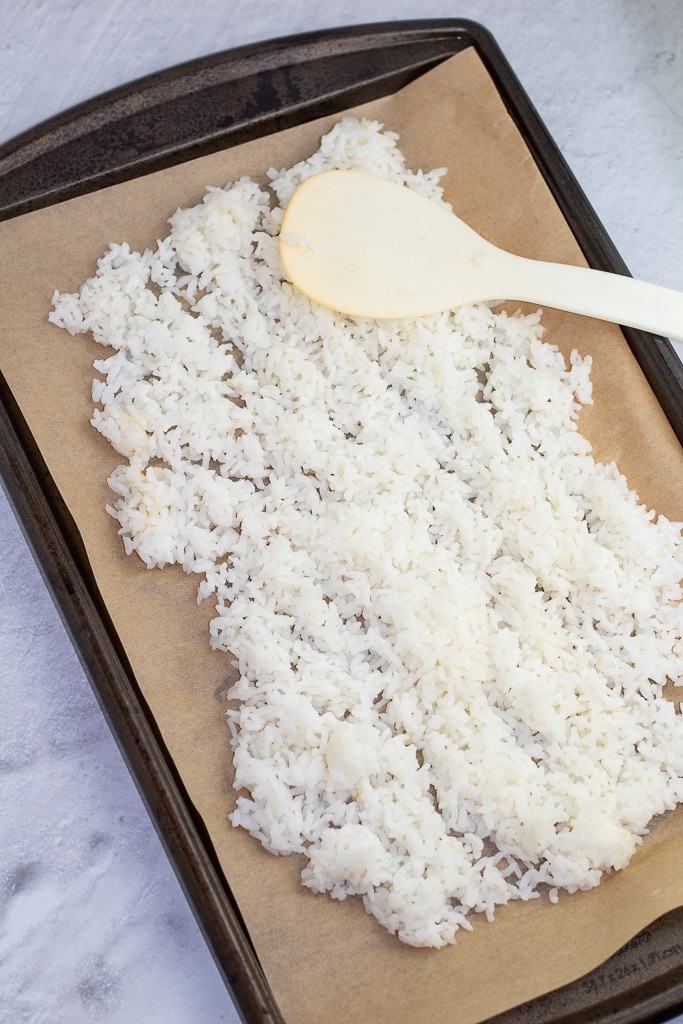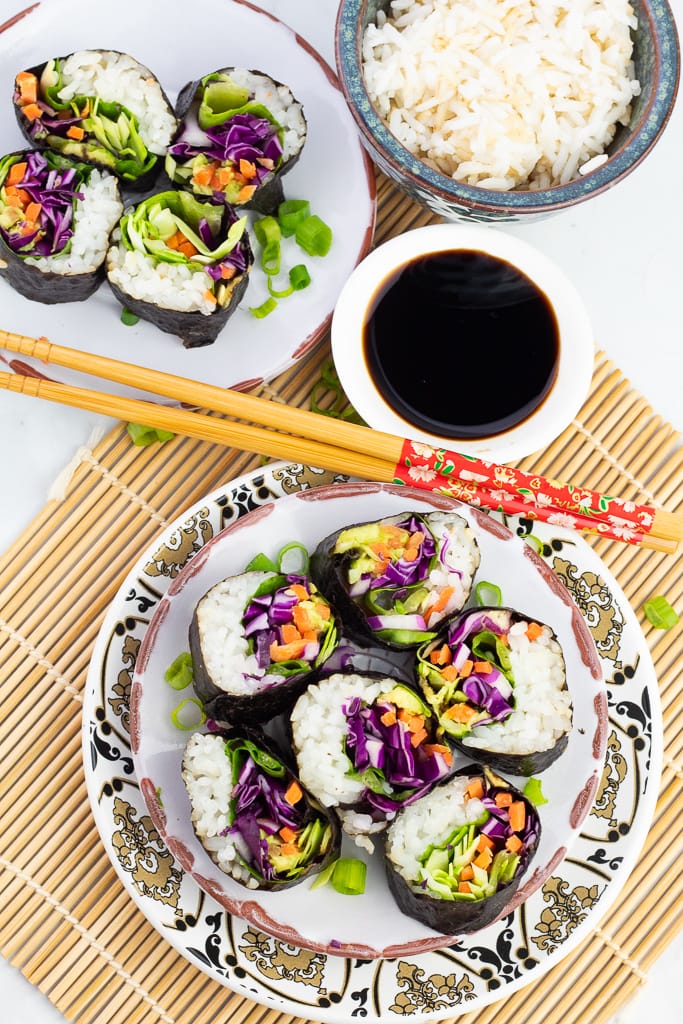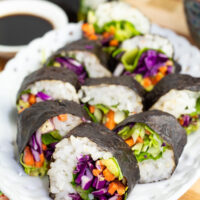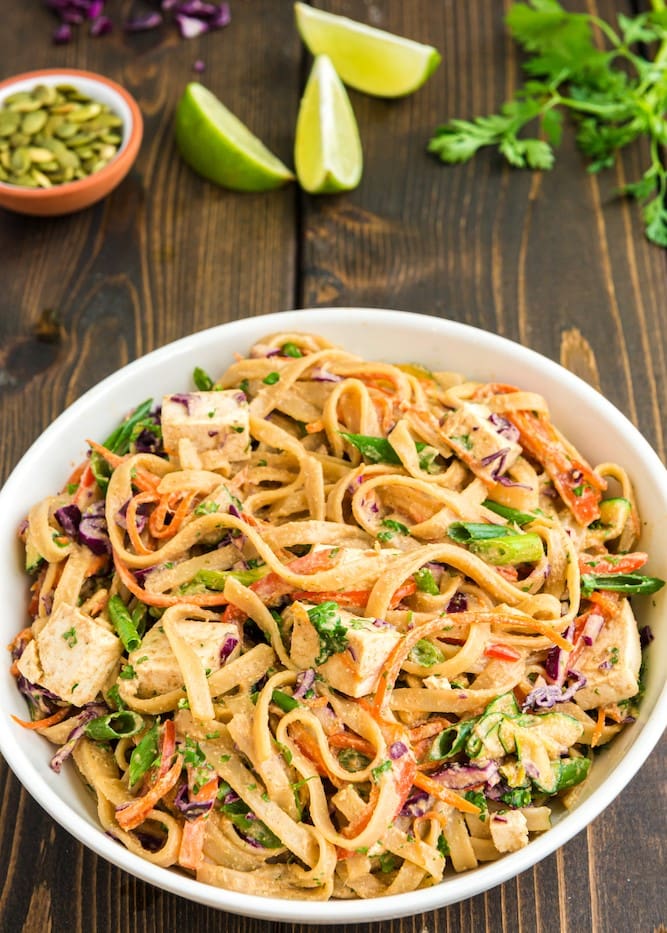Easy Vegan Veggie Sushi
We love Vegan Veggie Sushi, but it can be so expensive to buy in restaurants. The good news is that it’s easy to make at home, and you can customize it to include all the stuffings you like best!

Believe it or not, this vegetarian sushi recipe came from my sister who used to hate vegetables. No, I’m not kidding! You can read her story in this article, From Veggie Hater to Plant-Based. She also created this recipe for Sweet Potato Sushi Rolls that you should really try too.
She lived in Japan back in the 1980s and early 90s and knows a thing or two about cooking. I love to eat her food and learn the cooking methods that she developed from living in Asia. She has a wealth of information as you will see from this recipe and more to come. My Asian Oil-Free Stir Fry Sauce was inspired by her and one of her Japanese friends.
Ingredients you will need
It doesn’t take fancy ingredients or a lot of time to make your own homemade vegetable sushi. Actually, it’s pretty fun to do and is a terrific time to get the family in the kitchen.
- Rice- Short grain (or medium grain) rice is what you’ll need to buy to make sushi. This article on How to Make Sushi Rice can help explain the importance of the choice of rice. Haiga Brown Rice is a good option because it is short-grain and sticky.
- Rice seasonings- The ingredients used to flavor sushi rice are rice vinegar, sugar, and salt.
- Nori sheets- These are basically edible seaweed sheets that wrap around the outside of sushi and are used with maki rolls. They are completely optional but do add a nice salty flavor.
- Sesame seeds- Uramaki is the type of roll that uses sesame seeds on the outside instead of nori sheets. They are optional for making sushi.
- Vegetables- Raw sliced vegetables make up the stuffing for vegan sushi, and we’ve included a list below of some of the most commonly used options.
- Optional stuffings- Other stuffing ideas could include tofu or tempeh and even fruit like mango and pineapple. Also, try my Vegan Cashew Cream Cheese.
Optional (but helpful) equipment
You don’t have to have these items, but they sure do make the process a whole lot easier.
- Sushi rolling mat- Sushi making is much easier when you have a mat. They are very inexpensive and can be ordered online.
- Gallon-sized twist-tie plastic bag or plastic wrap- This helps keep your sushi mat clean and makes for easy cleanup. The bags can be ordered on Amazon.
- Good knives- These help with all the veggie chopping. Sharp knives are always best but watch those fingers. Serrated knives work best to slice the sushi rolls wrapped in Nori.
- Baking sheet- This will act as a cooling pan for the rice to be poured into after it is cooked.
- Extras- You will need a glass of water or a damp cloth for slicing.
How to make vegan sushi rolls
The recipe card at the bottom of the page has the full list of ingredients with measurements and instructions.
STEP #1: Begin by rinsing the rice under cold water. The best way to do this is by using a rice washing bowl or a colander that is made for small grains.
My sister, the recipe creator, uses a rice steamer to cook her sushi rice, and she suggests using short or medium-grain rice. The ratio for 8 sushi rolls is 2.5 cups uncooked rice to 2.25 cups water. Below are the different cooking methods.
- Rice steamer method- Place water and rice in the rice steamer and press the ‘Cook’ button or the applicable button for your model.
- Instant Pot method- Cook in your Instant Pot on high for 3 minutes and allow for a 10-minute slow release.
- Stovetop method- Cook over high heat without the lid until it comes to a boil. Cover, reduce the heat to medium-low, and allow to cook for approximately 12 minutes. Remove it from the heat, leave the lid on, and let it steam for another 10 minutes.
Whichever cooking method you use, be ready to transfer the cooked rice to a cooling pan as soon as it is done. If you are using a rice steamer, as soon as the cooker beeps, immediately transfer the rice to a cooling pan which can be as simple as a baking sheet. Be sure to have hot pads ready and be mindful of the steam.
STEP #2: While the rice cooks, go ahead and make the rice seasoning with the rice vinegar, sugar, and salt. Mix the ingredients together in a saucepan and heat on medium-high. Watch carefully, and turn the heat off when it begins to simmer. You don’t want this mixture to come to a boil.

STEP #3: When the rice has finished cooking, immediately dump it onto a baking sheet and pour the vinegar mixture over the top. Mix gently and begin spreading the rice out evenly.
Spreading it thinly will aid in cooling it more quickly. When you stir and spread the rice, do it gently so that the rice does not become mushy. I like to draw thin lines, with my rice paddle flipped on its side, down the length of the pan using a dragging motion to accomplish this.
STEP #4: Once the rice is coated with the mixture and cooling, the fun begins! In Japan, they often set the pan under a ceiling fan or make it a group event and use paper fans or a piece of cardboard to fan and aid in cooling the rice down quickly.
Slicing the vegetables
STEP #5: Cutting the vegetables into long thick strips or Julienne style will help to spread them alongside each other to create the long, neat, horizontal rows you’re accustomed to seeing. Below are some of the most common veggies used in sushi. The more colorful, the better!
- Romaine Lettuce
- Carrots
- Cabbages (red & green)
- Radishes
- Bell Peppers
- Avocado
- Cucumber
- Oshinko (pickled daikon)
- Broccoli sprouts
- Broccoli
- Pineapple
- Mango
STEP #6: Begin by sliding your sushi mat into a twist-tie gallon-sized plastic bag or covering it with plastic wrap because it will greatly simplify the rolling and clean-up processes.
There are two main types of rolls that we use when making veggie sushi at home. We are going to be doing maki rolls and using nori sheets for this recipe. In an upcoming article, we’ll cover the uramaki rolling technic as well.
- Maki rolls- These use nori seaweed sheets on the outside of the rolls.
- Uramaki rolls- Instead of seaweed, these rolls use sesame seeds on the outside.
STEP #7: On your bamboo sushi rolling mat covered in plastic, place a sheet of nori with the rough side up, and the lines running in the same direction as the bamboo mat. If you need a little help, this article on How to Roll Sushi includes a short video.
Spread the rice all the way out to the edges. You can use a rubber spatula, your rice paddle, or your damp fingertips to smooth it more evenly if you need to. For a maki roll, with the nori on the outside, go all the way out to the very edge except for the one furthest from you. Leave about a ½-inch edge of nori on the far end blank, that will help seal the roll later.
STEP #8: Begin to add your ingredients. I add mine in the center. You want to lay out your fillings in a horizontal row. Try to keep them close enough to bundle together easily.

STEP #9: Starting at the end closest to you, carefully lift the edge of the mat to bring it up and over the fillings. Begin rolling, using the mat to encourage the roll to take on a circular shape. As you roll, gently squeeze to tighten the roll up as it forms. This will help compress the rice enough to hold it together, which will keep the sushi from falling apart. Take care not to let the bamboo mat or the plastic wrap get caught up in the roll.

STEP #10: When the roll is completely formed, use your fingers and run them along the ½-inch strip of nori that was left uncovered at the end with dampened fingers. This will help the edge to stick to the outside of the roll, creating a secure seal. If you are using hummus, homemade vegan cream cheese, or plant-based homemade mayo in your sushi, you can also use these ingredients along the edges to seal the roll.
Cutting the sushi rolls
Lightly wet a serrated or very sharp knife and begin slicing the sushi into even pieces. Every so often, you will probably need to clean off the knife and wet it again to keep the slices neat.
If you are planning to pack these for lunch or eat them for a meal at home, you may want to cut them in half for easier handling or just skip the cutting process altogether.
Dipping sauce options
Helpful tips and suggestions
- No mess- Sliding your mat into a gallon-sized twist-tie plastic bag or covering it with plastic wrap will greatly simplify the rolling and clean-up processes.
- Rice- Haiga Brown Rice is a good option because it is short-grain and sticky.
- Damp hands- Wetting your hands often while rolling the sushi will help with the stickiness.
- Storage- Wrap sushi rolls in plastic wrap individually to store. If you plan to slice them, wait until you’re ready to serve to slice. They can be stored in the refrigerator for up to 3 days.
- Bento box- Homemade sushi is great in bento boxes for packing lunches.

If you try this recipe, please let us know how you like it by rating it and leaving a comment. We love to hear from you!
Want to Save This Recipe?
Enter your email & I’ll send it to your inbox. Plus, get great new recipes from me every week!
By submitting this form, you consent to receive emails from EatPlant-Based

Vegan Sushi
Ingredients
- 2.5 cups uncooked short grain rice medium grain will work too
- 2.25 cups water
- 1/4 cup rice vinegar
- 1/2 cup pure cane sugar or maple syrup
- 1.5 teaspoons salt
- 8 nori seaweed sheets
- 2 cups sliced raw cabbage purple or green or both
- 1 cup julienne carrots
- 5 romaine lettuce leaves
- 1 medium cucumber
Instructions
Making the Rice:
- Begin by rinsing the rice under cold water. The best way to do this is by using a rice washing bowl or a colander that is made for small grains.
- My sister, the recipe creator, uses a rice steamer to cook her sushi rice, and she suggests using short or medium-grain rice. Add 2.5 cups rice and 2.25 cups water to your rice steamer and press the ‘cook’ button or the applicable button for your model. Below, in the NOTES section, are the cooking methods using a rice steamer, Instant Pot, and stovetop.
- Whichever cooking method you use, be ready to transfer the cooked rice to a cooling pan as soon as it is done. If you are using a rice steamer, as soon as the cooker beeps, immediately transfer the rice to a cooling pan which can be as simple as a baking sheet. Be sure to have hot pads ready and be mindful of the steam.
- While the rice cooks, go ahead and make the rice seasoning with rice vinegar, sweetener, and salt. Mix the ingredients together in a saucepan and heat on medium-high. Watch carefully, and turn the heat off when it begins to simmer. You don’t want this mixture to come to a boil.
- When the rice has finished cooking, immediately dump it onto a baking sheet and pour the vinegar mixture over the top. Mix gently and begin spreading the rice out evenly.
- Spreading it thinly will aid in cooling it more quickly. When you stir and spread the rice, do it gently so that the rice does not become mushy. I like to draw thin lines, with my rice paddle flipped on its side, down the length of the pan using a dragging motion to accomplish this.
- Once the rice is coated with the mixture and cooling, the fun begins! In Japan, they often set the pan under a ceiling fan or make it a group event and use paper fans or a piece of cardboard to fan and aid in cooling the rice down quickly.
- Cutting the vegetables into long thick strips or Julienne style will help to spread them alongside each other to create the long, neat, horizontal rows you’re accustomed to seeing.
- These are some of the most common veggies used in sushi–Romaine lettuce, cabbages (red & green), carrots, radishes, bell pepper, avocado, cucumber, daikon, broccoli, broccoli sprouts, pineapple, and mango. The more colorful, the better!
- Begin by sliding your sushi mat into a twist-tie gallon-sized plastic bag or covering it with plastic wrap because it will greatly simplify the rolling and clean-up processes.
- There are two main types of rolls that we use when making veggie sushi at home. We are going to be doing maki rolls and using nori sheets for this recipe. In an upcoming article, we'll cover the uramaki rolling technic as well.
- On your bamboo sushi rolling mat covered in plastic, place a sheet of nori with the rough side up, and the lines running in the same direction as the bamboo mat.
- Spread the rice all the way out to the edges. You can use a rubber spatula, your rice paddle, or your damp fingertips to smooth it more evenly if you need to. For a maki roll, with the nori on the outside, go all the way out to the very edge except for the one furthest from you. Leave about a ½-inch edge of nori on the far end blank, that will help seal the roll later.
- Begin to add your ingredients. I add mine in the center. You want to lay out your fillings in a horizontal row. Try to keep them close enough to bundle together easily.
- Starting at the end closest to you, carefully lift the edge of the mat to bring it up and over the fillings. Begin rolling, using the mat to encourage the roll to take on a circular shape. As you roll, gently squeeze to tighten the roll up as it forms. This will help compress the rice enough to hold it together, which will keep the sushi from falling apart. Take care not to let the bamboo mat or the plastic wrap get caught up in the roll.
- When the roll is completely formed, use your fingers and run them along the ½-inch strip of nori that was left uncovered at the end with dampened fingers. This will help the edge to stick to the outside of the roll, creating a secure seal. If you are using hummus, homemade vegan cream cheese, or plant-based mayo in your sushi, you can also use these ingredients along the edges to seal the roll.
- Lightly wet a serrated or very sharp knife and begin slicing the sushi into even pieces. Every so often, you will probably need to clean off the knife and wet it again to keep the slices neat.
- If you are planning to pack these for lunch or eat them for a meal at home, you may want to cut them in half for easier handling or just skip the cutting process altogether.
Video
Notes
- Rice steamer method- Place water and rice in the rice steamer and press the ‘cook’ button or the applicable button for your model.
- Instant Pot method- Cook in your Instant Pot on high for 3 minutes and allow for a 10-minute slow release.
- Stovetop method- Cook over high heat without the lid until it comes to a boil. Cover, reduce the heat to medium-low, and allow to cook for approximately 12 minutes. Remove it from the heat, leave the lid on, and let it steam for another 10 minutes.
- No mess- Sliding your mat into a gallon-sized twist-tie plastic bag or covering it with plastic wrap will greatly simplify the rolling and clean-up processes.
- Rice- Haiga Brown Rice is a good option because it is short-grain and sticky.
- Damp hands- Wetting your hands often while rolling the sushi will help with the stickiness.
- Storage- Wrap sushi rolls in plastic wrap individually to store. If you plan to slice them, wait until you’re ready to serve to slice. They can be stored in the refrigerator for up to 3 days.
- Bento box- Homemade sushi is great in bento boxes for packing lunches.
Nutrition
Disclaimer
To obtain the most accurate representation of the nutritional information in a given recipe, you should calculate the nutritional information with the actual ingredients used in your recipe, using your preferred nutrition calculator. You are solely responsible for ensuring that any nutritional information provided is accurate, complete, and useful.
About the Chef
Drenda-Michell Brennan lived in Japan in the 1980s and 90s where she enjoyed spending much of her time visiting the kitchens of family and friends, watching and learning to prepare traditional Japanese cuisine. She is the mother of three Japanese-American grown children and grandmother (HuneyGram) to nine grandchildren. Read More…





